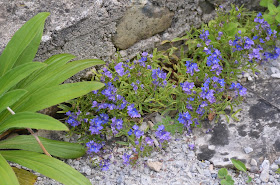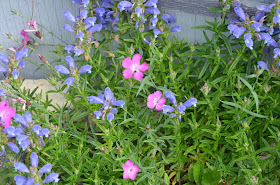 |
| Calceolaria mexicana |
The best plant I have become acquainted with in 2015 is also a half-hardy annual you collect the seeds of in the autumn: Eritrichium rupestre. A forget-me-not look alike, but much darker (and later). Both of these wonderful plants I got from my gardening friend, Glen, who has a knack for discovering interesting plants.
I have taken several pictures of blue flowers, but I waited so long to do this post that many, like the following one, have now mostly finished blooming.
 |
| Creeping Veronica Goldwell |
 |
| The native Blue Star |
Several sedums that have yellow flowers are now in bloom. The best one is probably Sedum Ellacombianum. The second is the Welsh stonecrop - Sedum fosterianum
 | |
Several blue or bluish Campanulas are in bloom.
 |
| Clustered bellflower |
Nepeta "Walkers Low".
 |
| Catnip with Digitalis lutea in the background |
A combination of yellow centres with bluish mauve petals, an improved version of one of our native weeds.
 |
| An improved fleabane |
Another beautiful blue plant Dracocephalum argunense with a few straggling Dianthus.
I end with a picture obviously taken outside the garden. This is how several of the fields around us look with canola in full bloom. Canola, which is grown for oil, was bred naturally from rapeseed at theUniversity of Manitoba here in Canada.
 |
| Canola |




Thanks for your pic of Nepeta 'Walkers Low'. I just got a couple.. Looking forward to them getting bigger now! The campanula is a beautiful blue.
ReplyDeleteI find the calceolaria a law onto itself as when and where it germinates but when it does pop up it is delight
ReplyDeleteIs Canola like our oil seed rape, During May we have fields of it dominating the landscape and self seeding everywhere I hate it,
ReplyDeleteA great idea to post by color. I'm even a fan of the native "weed" Daisy Fleabane--well, in the right spot, anyway. ;-) Do you find that the Campanula is invasive? It's a stunning flower, but someone had mentioned it can creep quite a bit. Gorgeous images!
ReplyDeleteAs soon as I read Eritrichium I remembered Eritrichium nanum - The King of the Alps from my alpine growing days, it is one of the most difficult plants to grow and flower in cultivation, luckily the delightful species you grow Alain doesn't seem as demanding.
ReplyDeleteI can smell that field over here in Scotland Alain! Yuk!!
ReplyDeleteSome lovely bloom and I particularly like the Telekia, it's a new one on me and it looks very attractive.
Telekia speciosa is on my wish list. I also love the Calceolaria mexicana at the top of the post.
ReplyDeleteHello Alain, the picture of the yellow field at the end reminds me of the fields of farmed oil seed rape that were all around where we used to live. Every summer these fields light up in a blinding bright yellow. I miss seeing that.
ReplyDeleteBeautiful picture is the last one Alain! I love blue flowers as well and the blue star is pretty. I have some blur muscari, campanula, pushkinia.
ReplyDelete